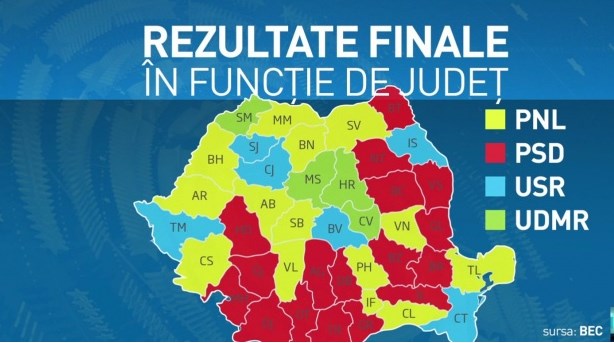As broadly anticipated in the pre-election piece on Romania, the country’s main right-wing party won the European elections, the National Liberal Party (EPP), which gathers most elements of previous right-wing governments, gained nearly 27% of the votes. On second place came the Social Democratic Party (PSD), currently in government, with about 22.5% of the votes – half of what they got in the last general elections in 2016! The other high score was obtained by the USR-Plus alliance, which gained nearly 22% of the votes and is made of two centre-right liberal parties that are likely to seek a broader coalition with the National Liberal Party. The three remaining parties that gained two seats each with scores between 5% and 7% are PRO Romania (split from PSD), the Popular Movement Party (led by former right-wing President Basescu) and the Democratic Alliance of Hungarians in Romania (centre-right).

Governing Social Democrats (PSD) Lost
PSD’s sharp loss of popular support is largely due to the abandonment of any social democratic agenda apart from some minimal social concessions such as insufficient increases in the minimum wage and pensions. On top of that, over the past few years, the party leader Liviu Dragnea faced multiple corruption charges, hence the repeated attempts of the PSD-led parliamentary majority to undermine the anti-corruption legislation. However, some of those attempts were defeated on Sunday in a referendum summoned by the President Iohannis on the same days as the European elections, which was motivated though by Iohannis’ affiliation to the National Liberal Party rather than any genuine commitment to tackling corruption, as he himself cannot fully account for the six houses that he owns.
PSD And Corruption
Moreover, immediately after PSD’s bad result, on Monday its leader Dragnea was finally convicted for three and half years in prison, with no possibility of appeal, for clientelist distribution of jobs in public institutions to close associates. Dragnea is an oligarch who has captured an entire county (Teleorman) in the south of the country through a complex web of family, friends and loyal men. His case is paradigmatic for the rise of domestic capitalist elites after 1989, which had to rely on corruption and clientelism to gain capital and compete to some extent with the stronger foreign capital (whose support for the highly politicised, neoliberal ‘anti-corruption’ crusade in Romania makes perfect sense).
PSD is the main political arm of these domestic oligarchs (commonly called ‘local barons’ in Romania), who are now fighting each other to replace Dragnea at the top of the party. Unfortunately, there is no movement from below or any reformist wing that might give the hope of an internal regeneration and shift to the left. Thus, PSD will continue to represent the class interests of domestic capital and bureaucratic networks, as it has done since its very foundation.
Socialist Party Is Way Lagging Behind Expectations
The only other left party that took part in these elections, the Romanian Socialist Party (PSR), got merely 40,000 votes, which represents barely 0.45% of the votes and five times less than the 200,000 signatures that the law requires for a party to stand in elections (Demos, the only other party that can confidently be placed on the left in Romania today only managed to gather about 20,000 signatures). PSR’s poor score is largely explained by its very limited activity between elections: no presence in the workplaces, in local communities, in schools or universities, or on demos and strikes. Their very limited off-line activity is rather symbolical and irrelevant, such as uncritical displays of solidarity with the Venezuelan government rather than any concrete action to support the wave of strikes that has been taking place in Romania in the recent period.
No Hope For Precarised
As indicated already, the other mainstream parties present no hope either for the millions of Romanians working home or abroad on low wages and in precarious conditions. For instance, just this month, the Clean Clothes Campaign published a bleak report about the 400,000 people, mostly women, who work in the garment industry in the nearly 9,000 official and unofficial factories and sweatshops across Romania. Their average net salary is only €208/month, which is seven times less than the living wage (as calculated for a family of two adults and two children)! Most of them are ununionized and fearful of speaking to anybody outside their families about the dire conditions they work in.
People like them remain unrepresented politically, as all mainstream parties focus primarily on serving the interests and needs of foreign and/or domestic capital. No party’s agenda includes, for example, the demand for decent wages for workers or for the reintroduction of basic mechanisms for collective bargaining (removed in 2011 by a new labour code). This crisis of representation is painfully reflected in the complete lack of engagement of the political parties, including PSD, with the ongoing and impressive wave of strikes across the manufacturing sector. For instance, at this moment, strikers at Electroaparataj (the biggest manufacturer of low-voltage equipment in Romania) in the city of Targoviste are preparing a mass demonstration after one month of strike for better wages (solidarity messages can be sent at the union’s email address valahia1 [a] gmail.com)!
Socialist Alternative Needed
The task of building a new mass left-wing party to represent the interests of workers, youth and oppressed categories in Romania is more pressing than ever. Indeed, given the upsurge in class struggle, the wider shift in consciousness away from the neoliberal hegemony of the ‘90s and the bleak economic prospects, the context for such a new party is more propitious than ever in the last of 30 years. The labour movement and left have to come together to fulfil this historic task and provide the socialist alternative that people need.


